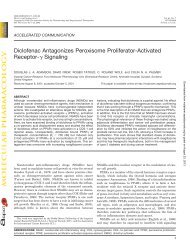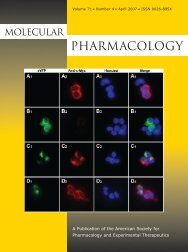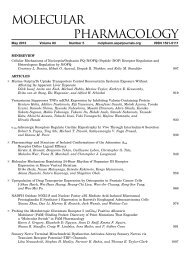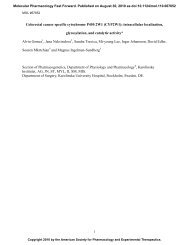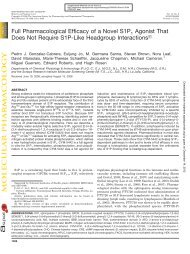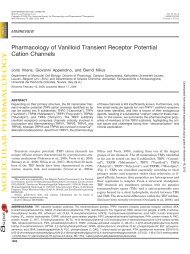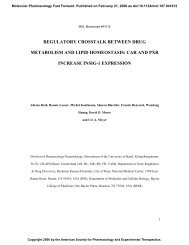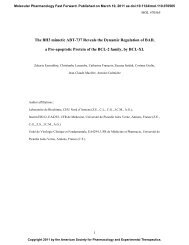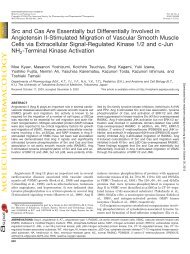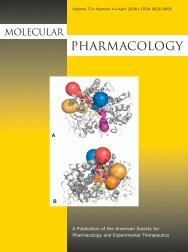Interaction Studies of Multiple Binding Sites on M4 Muscarinic ...
Interaction Studies of Multiple Binding Sites on M4 Muscarinic ...
Interaction Studies of Multiple Binding Sites on M4 Muscarinic ...
You also want an ePaper? Increase the reach of your titles
YUMPU automatically turns print PDFs into web optimized ePapers that Google loves.
Allosteric Cross-<str<strong>on</strong>g>Interacti<strong>on</strong></str<strong>on</strong>g>s at M 4 <strong>Muscarinic</strong> Receptors 743<br />
allosteric acti<strong>on</strong> in its own right; the lack <str<strong>on</strong>g>of</str<strong>on</strong>g> effect <str<strong>on</strong>g>of</str<strong>on</strong>g> C 7 /3-<br />
phth <strong>on</strong> WIN 62,577 potency, however, can <strong>on</strong>ly be accommodated<br />
by assuming a lack <str<strong>on</strong>g>of</str<strong>on</strong>g> interacti<strong>on</strong> between the two<br />
modulators (i.e., 1 <strong>on</strong> the [ 3 H]NMS-occupied receptor).<br />
Discussi<strong>on</strong><br />
This study has identified negative cooperativity between<br />
WIN 62,577 and prototypical modulators such as C 7 /3-phth,<br />
alcur<strong>on</strong>ium, or gallamine, indicating distinct cross-interacti<strong>on</strong>s<br />
between two separate allosteric sites <strong>on</strong> the orthosteric<br />
ligand-free M 4 mAChR. It is interesting to note that the<br />
interacti<strong>on</strong>s exhibit neutral cooperativity when the orthosteric<br />
site <strong>on</strong> the M 4 mAChR is occupied by either [ 3 H]QNB or<br />
[ 3 H]NMS. These findings have important implicati<strong>on</strong>s for<br />
combinati<strong>on</strong> drug therapies targeting disorders such as<br />
schizophrenia and pain, which are suggested to involve a<br />
significant M 4 mAChR comp<strong>on</strong>ent (Felder et al., 2000).<br />
Fig. 8. A, inhibiti<strong>on</strong> binding <str<strong>on</strong>g>of</str<strong>on</strong>g> alcur<strong>on</strong>ium against 0.1 (f), 0.5 (Œ), or 1<br />
nM () [ 3 H]QNB. B, inhibiti<strong>on</strong> binding <str<strong>on</strong>g>of</str<strong>on</strong>g> WIN 62,577 against [ 3 H]QNB<br />
in the absence (f) and presence <str<strong>on</strong>g>of</str<strong>on</strong>g> 10 (Œ), 30 (), 100 (), or 300 M (F)<br />
alcur<strong>on</strong>ium. All experiments were performed using CHO cell membranes<br />
expressing the M 4 mAChR. Data points represent the mean S.E.M. <str<strong>on</strong>g>of</str<strong>on</strong>g><br />
three to five experiments c<strong>on</strong>ducted in duplicate. All other details as for<br />
Fig. 3.<br />
WIN 51,708 and WIN 62,577 were originally identified by<br />
Lazareno et al. (2002) and are shown to exhibit different<br />
types <str<strong>on</strong>g>of</str<strong>on</strong>g> cooperativity with [ 3 H]NMS or ACh, depending <strong>on</strong><br />
the mAChR involved. We have extended these observati<strong>on</strong>s<br />
to characterize the interacti<strong>on</strong> between either modulator and<br />
[ 3 H]QNB. Our results highlight the dependence <str<strong>on</strong>g>of</str<strong>on</strong>g> allosteric<br />
interacti<strong>on</strong>s <strong>on</strong> the nature <str<strong>on</strong>g>of</str<strong>on</strong>g> the orthosteric ligand used as a<br />
“probe” to visualize the interacti<strong>on</strong>. As shown previously for<br />
prototypical modulators (Lee and el-Fakahany, 1988; Hejnova<br />
et al., 1995), the tropate [ 3 H]NMS can exhibit quite<br />
different behaviors to the benzilate [ 3 H]QNB when tested<br />
against the same allosteric compound. In our study, [ 3 H]QNB<br />
exhibited negative cooperativity with either benzimidazole at<br />
M 1 and M 4 mAChRs, whereas WIN 51,708 was negatively<br />
cooperative with [ 3 H]NMS at the M 1 mAChR and positively<br />
cooperative at the M 4 mAChR; the apparent inhibiti<strong>on</strong> <str<strong>on</strong>g>of</str<strong>on</strong>g><br />
[ 3 H]NMS binding by high c<strong>on</strong>centrati<strong>on</strong>s <str<strong>on</strong>g>of</str<strong>on</strong>g> WIN 51,708 at<br />
the M 4 mAChR is probably due to a kinetic artifact related to<br />
the ability <str<strong>on</strong>g>of</str<strong>on</strong>g> the compound to slow [ 3 H]NMS equilibrati<strong>on</strong><br />
time (Lazareno et al., 2002). It is noteworthy that the TCM<br />
also predicts that the affinity <str<strong>on</strong>g>of</str<strong>on</strong>g> the modulator for the free<br />
receptor should be independent <str<strong>on</strong>g>of</str<strong>on</strong>g> the probe used to quantify<br />
the interacti<strong>on</strong> (Ehlert, 1988). As shown in Table 1, this was<br />
indeed the case, because no significant differences were<br />
found between the logK B estimates <str<strong>on</strong>g>of</str<strong>on</strong>g> either modulator determined<br />
using [ 3 H]NMS relative to [ 3 H]QNB.<br />
The ligand-dependence <str<strong>on</strong>g>of</str<strong>on</strong>g> allosterism represents an important<br />
issue in drug discovery because orthosteric radioligands<br />
are still comm<strong>on</strong>ly used as receptor probes (Christopoulos,<br />
2002). If the cooperativity between orthosteric and allosteric<br />
ligands is low, then standard binding assays will lack the<br />
power to differentiate weak allosteric modulati<strong>on</strong> from a lack<br />
<str<strong>on</strong>g>of</str<strong>on</strong>g> effect. Our study provides a good example <str<strong>on</strong>g>of</str<strong>on</strong>g> the situati<strong>on</strong>,<br />
in which the combinati<strong>on</strong> <str<strong>on</strong>g>of</str<strong>on</strong>g> WIN 62,577 and [ 3 H]QNB at the<br />
M 4 mAChR yielded the best “window” <str<strong>on</strong>g>of</str<strong>on</strong>g> effect compared with<br />
all other combinati<strong>on</strong>s. For this reas<strong>on</strong>, the combinati<strong>on</strong> <str<strong>on</strong>g>of</str<strong>on</strong>g><br />
WIN 62,577 and [ 3 H]QNB was used to investigate the interactive<br />
properties <str<strong>on</strong>g>of</str<strong>on</strong>g> the modulator and other unlabeled orthosteric<br />
ligands. As shown in Figs. 5 and 6 and summarized in<br />
Table 2, the interacti<strong>on</strong> between WIN 62,577 and any <str<strong>on</strong>g>of</str<strong>on</strong>g> the<br />
orthosteric agents was negatively cooperative at the M 4<br />
mAChR. It is interesting, however, that the degree <str<strong>on</strong>g>of</str<strong>on</strong>g> interacti<strong>on</strong><br />
was modest between WIN 62,577 and ACh but very<br />
weak between WIN 62,577 and the antag<strong>on</strong>ist atropine or the<br />
ag<strong>on</strong>ists McN-A-343 and xanomeline. This suggests that it<br />
may be possible to attain a degree <str<strong>on</strong>g>of</str<strong>on</strong>g> absolute subtype selec-<br />
TABLE 3<br />
Radioligand binding parameters for the interacti<strong>on</strong> between 3 HQNB, WIN 62,577, and C 7 /3-phth, alcur<strong>on</strong>ium, or brucine at the M 4 mAChR<br />
Parameters derived from n<strong>on</strong>linear regressi<strong>on</strong> analysis are presented as the mean S.E.M. (n 3–5). LogK B is the logarithm <str<strong>on</strong>g>of</str<strong>on</strong>g> the modulator equilibrium dissociati<strong>on</strong><br />
c<strong>on</strong>stant at the free receptor. Log is the logarithm <str<strong>on</strong>g>of</str<strong>on</strong>g> the cooperativity factor for the interacti<strong>on</strong> between WIN 62,577 and 3 HQNB. Antilogarithm (geometric mean) is shown<br />
in parentheses. Log is the logarithm <str<strong>on</strong>g>of</str<strong>on</strong>g> the cooperativity factor for the interacti<strong>on</strong> between the indicated prototypical modulator and 3 HQNB. Antilogarithm (geometric<br />
mean) is shown in parentheses. Log is the logarithm <str<strong>on</strong>g>of</str<strong>on</strong>g> the cooperativity factor for the interacti<strong>on</strong> between WIN 62,577 and the indicated prototypical modulator <strong>on</strong> the<br />
3 HQNB-free receptor. Antilogarithm (geometric mean) is shown in parentheses. Log is the logarithm <str<strong>on</strong>g>of</str<strong>on</strong>g> the cooperativity factor for the interacti<strong>on</strong> between WIN 62,577<br />
and the indicated prototypical modulator <strong>on</strong> the 3 HQNB-occupied receptor. Antilogarithm (geometric mean) is shown in parentheses. In all instances, the value for Log<br />
was determined by an extra-sum-<str<strong>on</strong>g>of</str<strong>on</strong>g> squares test (F test) to not be significantly different from 0 (i.e., 1) and was c<strong>on</strong>strained as such in the analyses<br />
Allosteric Modulator LogK B Log Log Log Log<br />
C 7 /3-phth 5.81 0.22 2.69 0.03 (0.002) 1.02 0.04 (0.096) 0 (1)<br />
Alcur<strong>on</strong>ium 4.50 0.06 1.49 0.04 (0.032) 0.60 0.03 (0.25) 0 (1)<br />
Brucine 4.64 0.03 100 a (0) 0.31 0.06 (0.49) 0 (1)<br />
WIN 62,577 5.32 0.07 0.79 0.01 (0.16)<br />
a Irrespective <str<strong>on</strong>g>of</str<strong>on</strong>g> initial values, the n<strong>on</strong>linear regressi<strong>on</strong> algorithm always c<strong>on</strong>verged to the arbitrarily assigned boundary value <str<strong>on</strong>g>of</str<strong>on</strong>g> log 100, indicating that the degree<br />
<str<strong>on</strong>g>of</str<strong>on</strong>g> negative cooperativity between brucine and 3 HQNB was so high that it could not be distinguished from competiti<strong>on</strong> ( 0).



